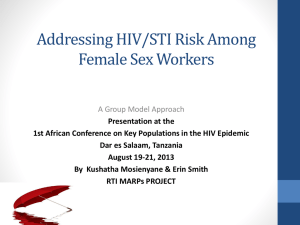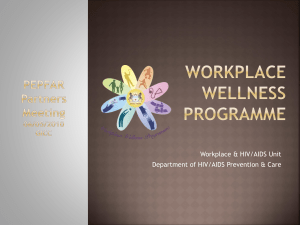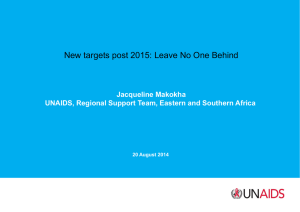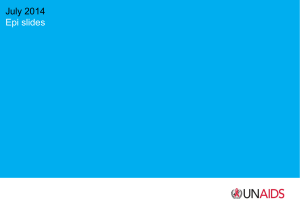PMTCT Graphics
advertisement
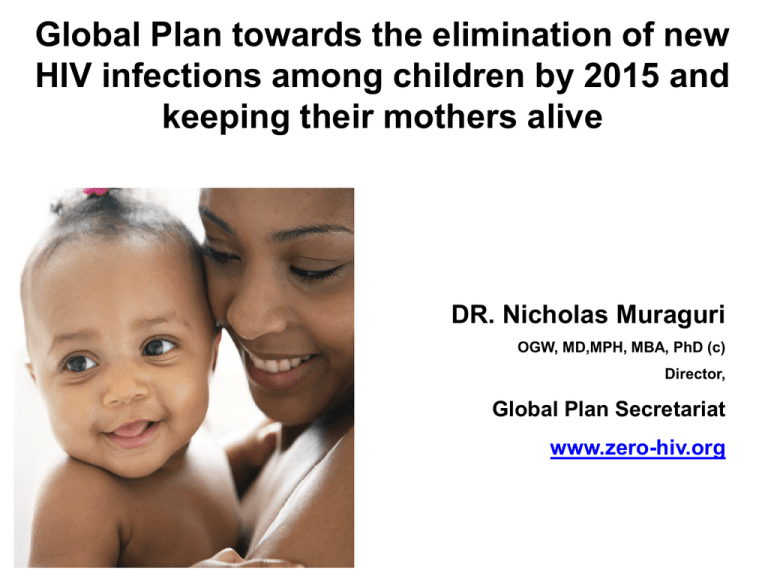
Global Plan towards the elimination of new HIV infections among children by 2015 and keeping their mothers alive DR. Nicholas Muraguri OGW, MD,MPH, MBA, PhD (c) Director, Global Plan Secretariat www.zero-hiv.org The Creation of the Global Plan Global Plan launched at UN High Level Meeting on AIDS in July 2011 as part of Political Declaration on AIDS Global Task Team co-chaired by Michel Sidibé and Ambassador Eric Goosby Membership of 40 countries, 30 civil society and private sector organizations, and 15 international and regional bodies/organizations FRAME IT There are 22 priority countries for the Global Plan 1. Angola 12. Lesotho 2. Botswana 13. Malawi 3. Burundi 14. Mozambique 4. Cameroon 15. Namibia 5. Chad 16. Nigeria 6. Côte d’Ivoire 17. South Africa 7. DR Congo 18. Swaziland 8. Ethiopia 19. Tanzania 9. Ghana 20. Uganda 10. India 21. Zambia 11. Kenya 22. Zimbabwe These countries accounted for 89% of all HIV-positive pregnant women in low- and middleincome countries in 2011 FRAME IT The gap in treatment and prophylaxis coverage is uneven among low- and middle-income countries The share of each low- and middleincome country in the total shortfall in providing antiretroviral medication to HIVpositive pregnant women to prevent new HIV infections among children. Lesotho, Côte d'Ivoire, Angola, Chad, Botswana, Swaziland, Ghana, Rwanda, Namibia, Brazil, South Sudan, South Africa, 3% Other low- and middle-income countries, 13% Nigeria 29% Chad, 2% Cameroon, 2% Zambia, 2% Tanzania, 4% Kenya, 5% Malawi, 5% Uganda, 8% Zimbabwe, 5% Dem. Rep. of Congo, 5% Mozambique, 7% Ethiopia, 5% India, 6% Source: UNAIDS 2012 2- Specific targets for 2015 90% Reduce the number of new HIV infections among children by 90% from a baseline of 2009 50% reduction in AIDS-related maternal deaths DO IT A four-pronged approach is required to prevent new HIV infections among children and keep mothers alive 1. Prevent HIV among women of reproductive age 2. Prevent unintended pregnancies among women living with HIV 3. Prevent HIV transmission through antiretroviral treatment during pregnancy and breastfeeding 4. Treatment, care and support for mothers living with HIV, their children, partners and families Progress Toward Global Plan Targets 100% 100% 90% 90% 90% 90% 2009 Baseline 80% 2011 70% 2015 Target 61% 60% 40% 30% 50% 48% 50% 34% 26% 28% 28% 21% 21% 20% 16% 10% Baseline 5% Baseline 0.5% 0% Reduce new cases of pediatric HIV infection MTCT rate Maternal ARV coverage ART coverage for mothers Reduction in maternal AIDS deaths Source: Towards Universal Access, 2011; Global Report, UNAIDS, 2012 ART coverage for children Number of new child infections, 21 priority countries 600,000 500,000 400,000 300,000 200,000 100,000 0 Source: UNAIDS Estimates 2012 New HIV infections among children, 2009–2011 Will reach the target if the 2009–2011 decline of more than 30% continues through 2015. Can reach the target if the decline in 2009–2011 of 20–30% is accelerated. In danger of not reaching the target, with a decline in 2009– 2011 of less than 20%. Note: The baseline year for the Global Plan is 2009. Some countries had already made important progress in reducing the number of new HIV infections among children in the years before 2009, notably Botswana which by 2009 already had 92% coverage of antiretroviral regimens among pregnant women and a transmission rate of 5% (see table pp122–123). In countries with high coverage, further declines are much harder to achieve. Source: UNAIDS Estimates 2012 Slight decline in new HIV infections among women 15-49, 21 priority countries 1200000 1000000 800000 600000 400000 200000 0 2000 2001 2002 2003 2004 2005 2006 2007 2008 2009 2010 2011 Source: UNAIDS Estimates 2012 Reduction in unmet need for family planning is slow, countries with available data 40 35 Percent 30 25 20 15 10 5 0 Source: Demographic and Health Surveys 2000-2011 Survey 1 Survey 2 … As a results the number of women in need of PMTCT services remains flat 1,800,000 1,600,000 1,400,000 1,200,000 1,000,000 800,000 600,000 400,000 200,000 0 2000 2001 2002 2003 2004 2005 2006 2007 2008 2009 2010 2011 Source: UNAIDS Estimates 2012 New child HIV infections and PMTCT coverage, 21 priority countries 450,000 400,000 100 470,000 450,000 420,000 400,000 370,000 Before the Global Plan 350,000 300,000 90 80 70 320,000 280,000 60 250,000 50 200,000 40 150,000 100,000 50,000 14 23 33 43 48 50 30 61 20 37,000 - 10 - 2005 2006 2007 2008 2009 2010 2011 2012 2013 2014 2015 Percent of HIV+ pregnant women receiving any ARV medicines (including SdNVP) Percent of HIV+ pregnant women receiving effective ARV medicines (excluding SdNVP) Source: UNAIDS Estimates 2012 Coverage Number of new child infections 500,000 PMTCT coverage, 21 priority countries High coverage 66+ % Medium coverage 33-65% Low coverage <33% Botswana Côte d’Ivoire Ghana Kenya Namibia Swaziland South Africa Tanzania Zambia Burundi Cameroon Lesotho Malawi Mozambique Uganda Zimbabwe Angola Chad DR Congo Ethiopia Nigeria Source: UNAIDS Estimates 2012 Prophylaxis coverage: the other half of the picture Number of women/infant pairs receiving prophylaxis, 2011, 21 priority countries 1400000 1200000 1000000 None 800000 sd NVP 600000 Dual Option A/B 400000 ART 200000 0 During pregnancy Source: UNAIDS Estimates 2012 During breastfeeding As a result … MTCT transmission rates are still high MTCT rate (percent) Dem Rep of Congo Angola Chad Nigeria Ethiopia Mozambique Cote dIvoire Ghana Malawi Cameroon Lesotho Burundi United Republic of Tanzania Zimbabwe Uganda Kenya South Africa Swaziland Zambia Namibia Botswana 0% Source: UNAIDS Estimates 2012 5% 10% 15% 20% 25% 30% 35% 40% Looking to the (near) Future: B+ Evidence Needs for WHO 2013 Guidelines Evidence and Lessons for Other Countries • • • • • Acceptability to women Adherence and retention Linkages with ART Implementability Impact -– Mother’s health – Vertical transmission – Prevention of sexual transmission Prong 4: Care and treatment for the family Early Infant diagnosis is still unacceptably low: 35% in 21 countries High coverage 66+ % Medium coverage 33-65% Low coverage <33% Kenya Lesotho South Africa Botswana Côte d'Ivoire Namibia Swaziland Angola Burundi DR Congo Ethiopia Ghana Mozambique Nigeria Tanzania Uganda Zambia Zimbabwe Source: Global AIDS Progress Reporting 2012 Maternal survival is important for child growth and development. Increasing ART results in substantial declines in pregnancy-related deaths Percent change in pregnancy-related deaths to women living with HIV between 2005 and 2010 Source: WHO, 2012. Trends in Maternal Mortality 1990-2010 Swaziland South Africa Namibia Botswana Lesotho Zimbabwe Zambia Malawi Mozambique Uganda Kenya Tanzania Côte d'Ivoire Cameroon Nigeria Ghana Burundi Angola Ethiopia DR Congo Chad India 80 70 60 50 40 30 20 10 0 TOGETHER WE WILL END AIDS Actions needed to reach zero • Strengthen efforts to reduce unmet need for family planning • Limited data on unmet need among women living with HIV • Increase coverage of prophylaxis during breastfeeding • Ensure eligible children receive ART • Increasing early infant diagnosis from 35% to higher levels will improve ART uptake • Integrating PMTCT into maternal and child health services. Thank you

